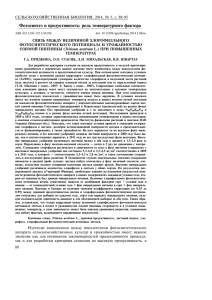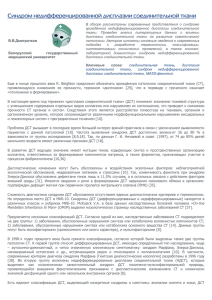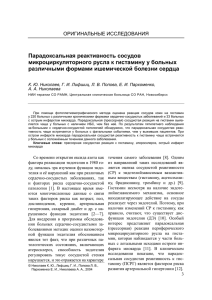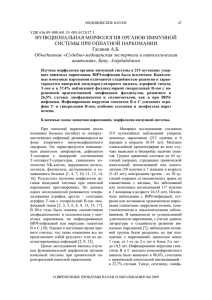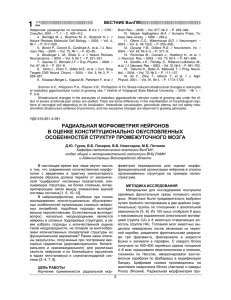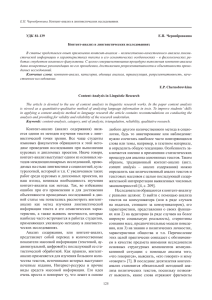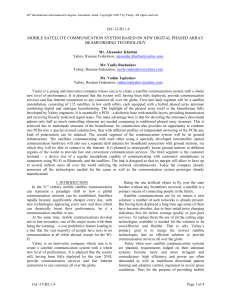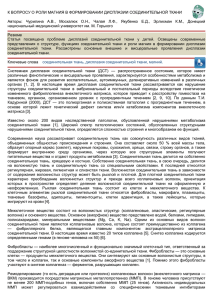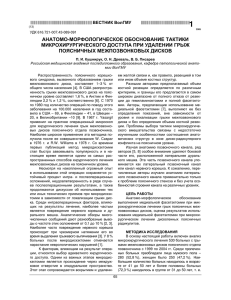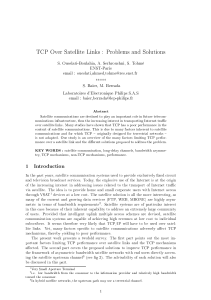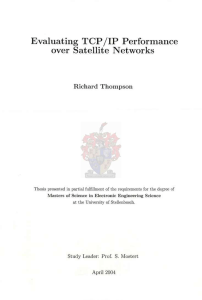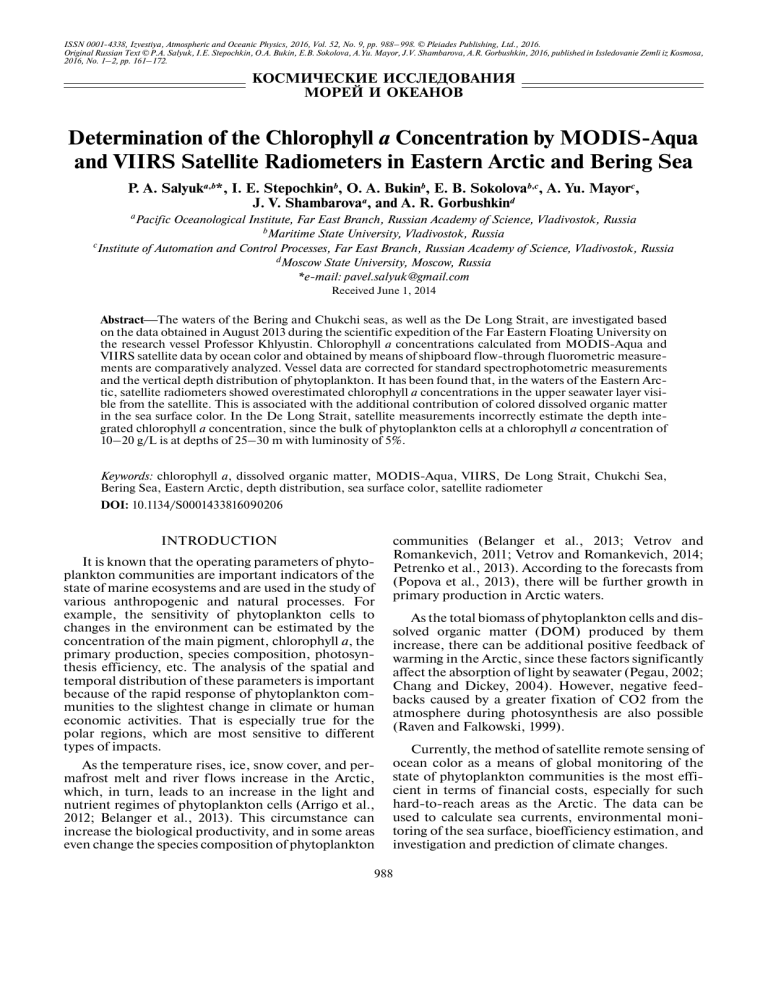
ISSN 0001-4338, Izvestiya, Atmospheric and Oceanic Physics, 2016, Vol. 52, No. 9, pp. 988–998. © Pleiades Publishing, Ltd., 2016.
Original Russian Text © P.A. Salyuk, I.E. Stepochkin, O.A. Bukin, E.B. Sokolova, A.Yu. Mayor, J.V. Shambarova, A.R. Gorbushkin, 2016, published in Issledovanie Zemli iz Kosmosa,
2016, No. 1–2, pp. 161–172.
КОСМИЧЕСКИЕ ИССЛЕДОВАНИЯ
МОРЕЙ И ОКЕАНОВ
Determination of the Chlorophyll a Concentration by MODIS-Aqua
and VIIRS Satellite Radiometers in Eastern Arctic and Bering Sea
P. A. Salyuka,b*, I. E. Stepochkinb, O. A. Bukinb, E. B. Sokolovab,c, A. Yu. Mayorc,
J. V. Shambarovaa, and A. R. Gorbushkind
aPacific
Oceanological Institute, Far East Branch, Russian Academy of Science, Vladivostok, Russia
b
Maritime State University, Vladivostok, Russia
c
Institute of Automation and Control Processes, Far East Branch, Russian Academy of Science, Vladivostok, Russia
d
Moscow State University, Moscow, Russia
*e-mail: [email protected]
Received June 1, 2014
Abstract⎯The waters of the Bering and Chukchi seas, as well as the De Long Strait, are investigated based
on the data obtained in August 2013 during the scientific expedition of the Far Eastern Floating University on
the research vessel Professor Khlyustin. Chlorophyll a concentrations calculated from MODIS-Aqua and
VIIRS satellite data by ocean color and obtained by means of shipboard flow-through fluorometric measurements are comparatively analyzed. Vessel data are corrected for standard spectrophotometric measurements
and the vertical depth distribution of phytoplankton. It has been found that, in the waters of the Eastern Arctic, satellite radiometers showed overestimated chlorophyll a concentrations in the upper seawater layer visible from the satellite. This is associated with the additional contribution of colored dissolved organic matter
in the sea surface color. In the De Long Strait, satellite measurements incorrectly estimate the depth integrated chlorophyll a concentration, since the bulk of phytoplankton cells at a chlorophyll a concentration of
10–20 g/L is at depths of 25–30 m with luminosity of 5%.
Keywords: chlorophyll a, dissolved organic matter, MODIS-Aqua, VIIRS, De Long Strait, Chukchi Sea,
Bering Sea, Eastern Arctic, depth distribution, sea surface color, satellite radiometer
DOI: 10.1134/S0001433816090206
INTRODUCTION
It is known that the operating parameters of phytoplankton communities are important indicators of the
state of marine ecosystems and are used in the study of
various anthropogenic and natural processes. For
example, the sensitivity of phytoplankton cells to
changes in the environment can be estimated by the
concentration of the main pigment, chlorophyll a, the
primary production, species composition, photosynthesis efficiency, etc. The analysis of the spatial and
temporal distribution of these parameters is important
because of the rapid response of phytoplankton communities to the slightest change in climate or human
economic activities. That is especially true for the
polar regions, which are most sensitive to different
types of impacts.
As the temperature rises, ice, snow cover, and permafrost melt and river flows increase in the Arctic,
which, in turn, leads to an increase in the light and
nutrient regimes of phytoplankton cells (Arrigo et al.,
2012; Belanger et al., 2013). This circumstance can
increase the biological productivity, and in some areas
even change the species composition of phytoplankton
communities (Belanger et al., 2013; Vetrov and
Romankevich, 2011; Vetrov and Romankevich, 2014;
Petrenko et al., 2013). According to the forecasts from
(Popova et al., 2013), there will be further growth in
primary production in Arctic waters.
As the total biomass of phytoplankton cells and dissolved organic matter (DOM) produced by them
increase, there can be additional positive feedback of
warming in the Arctic, since these factors significantly
affect the absorption of light by seawater (Pegau, 2002;
Chang and Dickey, 2004). However, negative feedbacks caused by a greater fixation of CO2 from the
atmosphere during photosynthesis are also possible
(Raven and Falkowski, 1999).
Currently, the method of satellite remote sensing of
ocean color as a means of global monitoring of the
state of phytoplankton communities is the most efficient in terms of financial costs, especially for such
hard-to-reach areas as the Arctic. The data can be
used to calculate sea currents, environmental monitoring of the sea surface, bioefficiency estimation, and
investigation and prediction of climate changes.
988
DETERMINATION OF THE CHLOROPHYLL a CONCENTRATION
When using the method in the polar regions, it is
necessary to take into account a number of specific
conditions that can affect the quality of the received
satellite information (Kravchishina et al., 2013;
Kuznetsova et al., 2013; Burenkov et al., 2011; Petrenko et al., 2012): the presence of ice, frequent cloudiness, low zenith angles of the Sun, low atmospheric
aerosol concentration, special stratification, functional condition, and species composition of phytoplankton communities. Simultaneously, the relevance
of general problems of passive satellite optical monitoring remains. These include the problem of correctly
determining sea brightness coefficients and the chlorophyll a concentration in coastal waters and in waters
subject to the influence of river runoffs (Remote…,
2000; Salyuk et al., 2013a; Bondur and Grebenyuk,
2001; Bondur, 2004) and the solution of inverse problems of optical radiation passing through the atmosphere (Kopelevich et al., 2009).
In the case of global estimates of bioefficiency
changes in the Arctic waters, the above factors or some
of them are often not considered because of the lack of
information about their significance and impact on
the calculation of the parameters that characterize the
functioning of phytoplankton communities.
The purpose of this investigation is to analyze the
accuracy of the determination of the chlorophyll a
concentration from satellite radiometers MODISAqua and VIIRS in the waters of the Bering Sea and
Eastern Arctic and to identify the main factors leading
to the observed errors.
N
72°
989
De Long
Strait
East Siberian Sea
CHUKCHI
SEA
69°
66°
63°
60°
BERING SEA
57°
162°
168°
174 °
180°
174 °
168° W
Fig. 1. Investigation area. Gray points indicate simultaneous measurements of the flow-through shipboard and satellite data. White circles refer to simultaneous flowthrough and submersible shipboard measurements.
Crosses show submersible shipboard measurements in the
De Long Strait.
INVESTIGATION REGIONS
toms, and other groups of algae prevail locally. The
spatial distribution of these complexes is largely determined by the local peculiarities of the hydrological
and nutrient regimes of the investigated regions
(Sergeeva et al., 2010).
The investigations were carried out in the Bering
and Chukchi seas and in the De Long Strait in August
2013 (see Fig. 1). During this period, the sea surface
was free of ice except for the part of the De Long Strait
where rapid melting was observed that led to the freshening of the upper 10-m seawater layer up to a salinity
of about 29‰.
Many biooptical measurements were carried out in
the Bering Sea and the eastern part of the Chukchi
Sea. Descriptions of these measurements are stored in
the databases on the concentration of chlorophyll a
and primary production in (Ardyna et al., 2013; Petrenko et al., 2012). It should be noted that in the western part of the Chukchi Sea and in the De Long Strait
far fewer such measurements were conducted. One of
the reasons was difficult ice conditions in the region.
In the Arctic seas in the ice-free water, one peak of
phytoplankton bloom is usually observed that falls
within the period from mid-July to September. However, a two-peak surge is also common. It is not that
dissipative in time, and both peaks are quite close to
each other (Sergeeva et al., 2010; Ardyna et al., 2013).
It was established that during the summer the main
dominant group in the Chukchi and Bering seas is dia-
METHODS AND INSTRUMENTS
Shipboard Measurements
Three water intake methods were used to measure
the chlorophyll a concentration (variable C): during
vessel movement from the system pumping water from
a depth of 5 m (flow index), during stops using submersible profiler (CTD index), and using the bathometer. For an analysis of the factors leading to the errors
of the satellite determination of the chlorophyll a concentration, the temperature and salinity of seawater,
photosynthetically active radiation (PAR, PAR variable), and the concentration of colored dissolved
organic matter (CDOM, D variable) were additionally
determined.
The following methods and instruments were used:
(1) During the vessel movement, the fluorescence
spectra, temperature, and salinity of seawater from the
pumping systems were measured and additional PAR
measurements on the deck were carried out. The
instrument complex included the following devices:
laser flow-through fluorometer (Maior et al., 2011.),
SeaBird SBE-45 thermosalinograph, Licor LI-190R
IZVESTIYA, ATMOSPHERIC AND OCEANIC PHYSICS
Vol. 52
No. 9
2016
990
SALYUK et al.
PAR sensor, and a GPS navigator. A detailed description of the complex was given in (Nagornyi et al.,
2014). Fluorometer measurements were carried out
with a spectral resolution of 1 nm and accumulation
time of 20 s, which corresponds to a spatial resolution
of 113 m at a cruising speed of 11 knots. Fluorescence
spectra of seawater normalized to the Raman scattering intensity of seawater were used to calculate fluorescence intensity of chlorophyll a I C and the fluorescence intensity of CDOM I D ;
(2) A SeaBird 19-plus submersible profiler with
standard pressure, temperature, and seawater-salinity
sensors was used during vessel stops. In addition,
pump-through fluorometric sensors of the concentration of chlorophyll a and CDOM, WETLabs WETStar-chlA, and WETStarCDOM, respectively, as well
as a spherical PAR sensor Licor LI-193, were installed
on the profiler. Calibration factors of the WETStarchlA sensor were obtained under laboratory conditions by the manufacturer by comparing the fluorescence intensity of chlorophyll a with the concentration
of its extracted molecules. WETStar-CDOM sensor
data were calibrated by the manufacturer to a solution
of quinine sulfate dihydrate in laboratory conditions.
It is known that in situ results of fluorometric measurements depend on changes in the species composition and functional state of phytoplankton cells, as
well as on the pump operation in the flow-through
system, which significantly affects the concentration
of living cells in water samples (Didenko et al., 1985).
Therefore, during the voyage, necessary regular calibrations of such measurements at different levels of
PAR and concentrations of chlorophyll a and CDOM
were carried out.
In order to achieve this goal, seawater samples from
the flow-through system of the ship and from the sea
surface were taken regularly during vessel movement,
and, during stops, in sync with the work of the SeaBird
SBE-19plus profiler, samples of seawater were taken at
different depths using a bathometer. In total, 60 samples were taken during the voyage. In the samples, the
chlorophyll a concentration was determined by the
standard spectrophotometric method according to
GOST (State Standard) 17.1.4.02-90.
Fluorometric measurements obtained using the
flow-through system of the ship (C flow , Dflow ) and a
submersible profiler (C CTD, DCTD ) were brought to a
single units of measurement of the chlorophyll a concentration corresponding to standard measurements
according to GOST and to CDOM concentration units
based on the WETStar- CDOM sensor calibration.
For each depth profile C CTD(z) and DCTD(z), optically balanced concentrations were determined, which
theoretically should be observed from the satellite
(index ow) (Salyuk et al., 2010; Smith and Baker,
1981). Integrals in terms of depth values (index z) were
also calculated.
ow(z ) = ( PARCTD(z )) ,
2
z 99
ow
C CTD
=
(1)
z 90
∫C
CTD ( z )ow( z )dz
0
∫ ow(z)dz ,
(2)
0
z bot
z
C CTD
= 1
z bot
C =
ow
C flow
∫ C(z)dz,
(3)
0
= pc1C flow + pc2,
(4)
where z is the depth, z90 is the depth at which the PAR
is 10% of the value above the sea surface, zbot is the bottom depth, and pс1 and pс2 are coefficients of linear
regression that recalculate the values obtained in the
flow-through system into optically weighted values.
The coefficients were obtained by comparing C flow
w
and C CTD
. Similar calculations were carried out for the
concentrations of CDOM D.
Optically weighted values of C and D most correctly reflect the contribution of phytoplankton cells
and CDOMs in the formation of the upward sea-surface radiation. These values should be compared with
satellite data.
Figure 2 shows a scatter plot between the values
w
w
w
z
and C CTD
(Fig. 2a), C = C flow
and C CTD
C = C flow
(Fig. 2b). Flow-through measurements of C at a depth
of 5 m are in good agreement with the results of submersible measurements averaged taking into account
the optical weight and, thus, can be used for comparison with the satellite data (Fig. 2a). In this case, flowthrough and, thus, optically weighted measurements
led to significant errors in the determination of the
chlorophyll a concentration averaged over the entire
sea thickness, although in general they reflected the
overall biological productivity of marine waters (Fig.
2b). A particularly strong mismatch was observed in
the area of the De Long Strait, where averaged-overdepth values were overestimated with respect to the
expected values by about 4–5 times.
Satellite Measurements
Level 2 Ocean Color satellite data obtained by radiometers MODIS-Aqua and VIIRS installed on Aqua
and Suomi-NPP satellites, respectively, and processed
by NASA procedures Reprocessing 2013.1 (Ocean…,
2014) were used for the analysis. The first radiometer
has been operating since 2002 and has established
itself as a reliable instrument for determining the chlorophyll a concentration in the waters of the first optical type. Data from the second radiometer have been
available since 2012. Thus, the analysis of the accuracy
of VIIRS measurements is of particular interest.
IZVESTIYA, ATMOSPHERIC AND OCEANIC PHYSICS
Vol. 52
No. 9
2016
DETERMINATION OF THE CHLOROPHYLL a CONCENTRATION
The spatial resolution of satellite images at the
nadir was MODIS-Aqua ≈ 1000 and VIIRS ≈ 750 m.
For each of the radiometers, sea-color indices were
calculated using the following formulas:
for the MODIS-Aqua radiometer (OC3M index),
Rrs ( 443) > Rrs ( 486)
(6)
,
Rrs (551)
where Rrs(λ) is the sea brightness factor at a given
wavelength λ.
Satellite chlorophyll a concentrations were calculated by the recommended global biooptical algorithms OC3M and OC3V (Werdell, 2010)
ROC3V = lg
C OC3M = 10 ^ (0.2424 − 2.7423ROC3M
2
3
4
+ 1.8017ROC3M
+ 0.0015ROC3M
− 1.2280ROC3M
),
C OC3V = 10 ^ (0.2228 − 2.4683ROC3V
2
3
4
+ 1.5867ROC
3V − 0.4275ROC 3V − 0.7768ROC3V ).
2.5
ow
CCTD
, mg/m3
(5)
(a)
3.0
2.0
1.5
1.0
0.5
0
1
2
3
2
3
С, mg/m3
(7)
(b)
3.0
(8)
Comparison of Shipboard and Satellite Data
Shipboard measurements obtained in the flowthrough system were used for comparison with the satellite data. Their advantage is a high spatial resolution
that makes it possible to filter outliers, to take into
account the presence of sharp gradients of the analyzed variables, and to accumulate statistics sufficient
for the analysis during a single voyage.
Since the results of the comparison of shipboard
and satellite data depend on the temporal and spatial
scales of averaging, interpolation, and approximation, the comparison was carried out in the ranges of
distances dr and time dt between shipboard and satellite measurements. The following values were
selected for the analysis: dr = ±1, ±2, ±4, ±6, ±8 km;
dt = ±1, ±2, ±3, ±4, ±6 h.
At the first stage of comparison, the entire series of
shipboard measurements was divided into individual
samples with a set of different values of dr and dt. For
each sample, mean and median values, standard deviation, spatial and temporal gradients of changes in the
concentration of chlorophyll a, and CDOMs were calculated. Samples with high relative measurement
errors, samples on the fronts of the fields of its concentration and CDOM, and samples in the presence of
significant diurnal variations were filtered.
At the second stage, pixels on satellite images with
centers spaced by less than dr and measured within the
time dt were selected with respect to the average geographic location and measurement time of each shipboard sample. If one and the same satellite pixel could
IZVESTIYA, ATMOSPHERIC AND OCEANIC PHYSICS
2.5
ow
CCTD
, mg/m3
Rrs ( 443) > Rrs ( 489)
,
Rrs (547)
and for the VIIRS radiometer (OC3V index),
ROC3M = lg
991
2.0
1.5
1.0
0.5
0
1
С, mg/m3
Fig. 2. Scatter plots of shipboard flow through (abscissa)
and submersible measurements of the chlorophyll a concentration (y axis). (a) Submersible data are averaged taking into account the optical weight based on formula (2).
(b) Submersible data are averaged over the sea thickness by
formula (3).
be attributed to two different shipboard samples, the
one with a shorter distance to the center was selected.
Statistical processing similar to the procedure
described above for shipboard samples was carried out
for every resulting sample of satellite data.
As a result, arrays of simultaneously measured
shipboard and satellite data were obtained with statistical estimates of the measurement accuracy and filVol. 52
No. 9
2016
992
SALYUK et al.
(a)
(b)
1.5
1.5
Algorithm
OC3M
1.0
0.5
0.5
lg(C)
lg(C)
1.0
Algorithm
OC3V
0
0
Flag
HISOLZEN
ΔROC3M
ΔROC3V
–0.5
–1.0
–0.5
–0.5
0.5
0
1.0
ROC3M
–1.0
–0.5
0
1.0
0.5
ROC3V
Fig. 3. Example of the comparison of the common logarithm of shipboard flow-through measurements of the chlorophyll a concentration (y axis) and satellite measurements of sea color index (x axis) for the scales dr = ±2 km and dt = ±2 h. Black points
indicate measurements in the Eastern Arctic: (a) satellite data from the MODIS-Aqua radiometer and (b) satellite data from the
VIIRS radiometer.
tered outliers, where each sample was independent of
the others.
During the comparative analysis, color indices calculated by satellite measurements according to formulas (5) and (6) were compared with the decimal logarithm of the chlorophyll a concentration measured at
the vessel, lg(C). The accuracy of global algorithms (7)
and (8) was estimated. For this purpose, the determination coefficient R2, the relative RMS error of the chlorophyll a concentration determination CVRMSE, and
the median value of the coefficient of proportionality
between the satellite and the shipboard estimates of the
chlorophyll a concentration biasmed were calculated.
number, and COC3 is the satellite estimation of the
chlorophyll a concentration made by formula (7) or (8)
depending on the satellite radiometer used.
The samples used for analysis were prefiltered to
eliminate the effect of outliers on the resulting estimates. For the calculations according to formulas (9),
(10), and (11), preliminary samples were eliminated
for which a null value of the weighting coefficient
(DuMouchel and O’Brien, 1989) was calculated
according to the biquadratic function of the vector of
residuals between the points on the scatterplot lg(С)–
lg(COC3) and the curve defined by algorithm (7) or (8).
N
R2 = 1 −
∑ (C
i
− C OC3 i )
RESULTS OF THE COMPARISON
OF SHIPBOARD AND SATELLITE DATA
2
i =1
⎛
1
⎜C i −
⎜
N
i =1 ⎝
N
∑
2
(9)
,
∑
(C i − C OC3 i ) 2
CVRMSE = NN
∑C
⎞
Ci ⎟
⎟
⎠
i =1
N
N
,
(10)
i
i =1
⎛C
⎞
(11)
bias med = median ⎜ OC3 i ⎟ ,
⎝ Ci ⎠
where N is the number of simultaneously measured
correct samples of shipboard and satellite data for the
given averaging scales dr and dt, i is the sample serial
Figure 3 shows an example of a scatterplot of seacolor indices determined by satellite radiometers and a
common logarithm of the shipboard measured chlorophyll a concentration with a comparison scale dr =
±2 km and dt = ±2 h. Coordinates of simultaneous
measurements are shown in Fig. 1 by solid gray dots.
Points related to Arctic waters of more than 66°N are
marked with black on the scatterplots in Fig. 3. Biooptical algorithms (7) and (8) in Figs. 3a and 3b, respectively, are marked with a solid curve. The position of
points in the scatterplots to the left of the curves indicates that satellite measurements overestimate the
chlorophyll concentration. The points circled in dotted lines are statistical outliers and are not used in further calculations.
IZVESTIYA, ATMOSPHERIC AND OCEANIC PHYSICS
Vol. 52
No. 9
2016
DETERMINATION OF THE CHLOROPHYLL a CONCENTRATION
ANALYSIS OF THE CAUSES LEADING
TO A MISMATCH BETWEEN SHIPBOARD
AND SATELLITE DATA
Let us analyze what can cause gross outliers,
errors, and biases in the determination of the concentration of chlorophyll a from MODIS-Aqua and
VIIRS radiometers.
Quality Flags of Satellite Data Measurements
For all satellite samples selected for comparative
analysis, quality flags l2_flags from the array of satellite data of the second level were analyzed. Part of the
outliers in the MODIS-Aqua data were systematically
caused by the HISOLZEN flag, which indicates that
the measurements were carried out at a high solarzenith angle, which was observed in the Arctic waters.
An example of such outliers is shown in Fig. 3a, where
the points are circled with dotted lines. Such points
were not observed in VIIRS data. It should be noted
that, in the third-level, data points with this flag are
automatically filtered for all satellite radiometers.
The remaining outliers did not have any flag that
would systematically indicate satellite data-processing
IZVESTIYA, ATMOSPHERIC AND OCEANIC PHYSICS
CCTD
0
2.2
4.4
6.6
8.8
11
DCTD
0.9
0
2.2
4.4
6.6
8.8
11
662.7
828.3
3
2
10
4
z, m
Because of the fact that the VIIRS radiometer has
a better resolution of the measured satellite images,
the example for VIIRS in Fig. 3 made it possible to
obtain more comparison points. This was observed by
us in almost all combinations of dr and dt used.
A similar analysis was carried out for all values of dr
and dt. Thus, in order to estimate the accuracy of each
of the satellite radiometers, only those shipboard data
samples were retained for which the weight ratio was
greater than zero simultaneously for MODIS-Aqua
and VIIRS. The comparison results are presented in
the table. The coefficients were calculated separately
for the waters of the Bering Sea and Eastern Arctic.
From the analysis of the values of coefficients R2
and CVRMSE it can be seen that at small scales and of
comparison of dr and dt (±(1–6) km and ±(1–4) h),
VIIRS data provide better accuracy in determining the
concentration of chlorophyll a. In the case of a largescale comparison (±8 km and ±6 h), MODIS-Aqua
data provide comparable or better accuracy. In eastern
Arctic waters, the VIIRS radiometer showed better
results compared to the MODIS-Aqua scanner. For
the VIIRS radiometer, the best concentration determination accuracy of chlorophyll a was achieved at
dr = ±(4-8) and dt = ±(1–2) h. For the MODIS-Aqua
radiometer, dr = ±8 and dt = ±(1–2) h.
From the values of the coefficient biasmed, it can be
seen that in general the estimates of analyzed radiometers give a correct idea about the chlorophyll a concentration in the upper layer of seawater. In eastern
Arctic waters, from the satellites its concentration was
overestimated by about 1.3–1.5 times.
993
20
1
30
40
PARCTD 0.1
ρCTD 1023
165.7
331.4
497
1023.7 1024.4 1025.1 1025.8 1026.5
Fig. 4. Depth distribution of the chlorophyll a concentration,
in mg/m3 (curve 1), CDOM concentration, in mg/m3 (2),
photosynthetically active radiation, μmol/m2/s (3), and sea
water density, g/m3 (4).
problems and they can be associated with both shipboard data-measurement errors and various satellite
data-processing problems listed in INTRODUCTION.
Vertical Distribution
of Optically Active Seawater Components
One of the reasons leading to significant errors in
the determination of the chlorophyll a concentration
in the upper layer of the sea is an incorrect account of
the vertical distribution of the optically active seawater
components. Figure 2a shows that flow-through measurements at a depth of 5 m adequately estimate the
chlorophyll a concentration, which should be
observed from the satellite. However, some points
measured in the De Long Strait and indicated with
crosses in Figs. 1 and 2b significantly fall out of the linear regression that connects surface measurements
and measurements averaged over the entire seawater
thickness. Let us analyze the corresponding vertical
distributions of optically active seawater components.
Figure 4 shows an example of the depth distribution C CTD(z), DCTD(z), PARCTD(z) , and seawater density ρ CTD(z), calculated from the measurements of
temperature and salinity. Profiles are averaged in
increments of 1 m.
It can be seen that the bulk of phytoplankton in that
region is at a depth of 25–30 m below the pycnocline,
while at the maximum density jump there is almost no
phytoplankton, and the CDOM is distributed according to seawater density gradients. Most likely, the light
Vol. 52
No. 9
2016
994
SALYUK et al.
Comparison of the accuracy of the determination of the chlorophyll a concentration from satellite radiometers VIIRS (V)
and MODIS-Aqua (A) by OC3V and OC3M algorithms, respectively
Bering Sea
Δr, Regions
Parameters
km
id
N
R2
Δt, h
±1
±2
±3
±4
±6
±4
±6
±1
±2
±3
±4
±6
VA
93
137
167
175
224
–
24
93
145
174
185
250
±2
VA
68
99
126
149
216
10
19
68
106
134
159
236
±4
VA
36
59
76
91
131
–
11
37
63
80
100
143
±6
VA
26
33
53
66
94
–
–
27
42
59
72
102
±8
VA
16
22
38
48
73
–
–
17
31
42
54
79
A
–
–
–
–
–
–
–
–
–
–
–
–
V
0.66
0.79
0.34
0.74
0.3
–
–
0.66
0.8
0.36
0.66
0.34
A
0.01
–
–
–
0.37
–
–
0.01
–
–
–
0.39
V
0.69
0.81
0.49
0.73
0.53
–
–
0.69
0.82
0.51
0.74
0.54
A
0.12
0.06
0.3
0.27
0.65
–
–
0.12
0.1
0.32
0.3
0.66
V
0.88
0.86
0.61
0.68
0.59
–
0.21
0.88
0.86
0.62
0.69
0.46
A
0.5
0.47
0.47
0.48
0.66
–
–
0.49
0.51
0.45
0.49
0.67
V
0.87
0.83
0.75
0.52
0.59
–
–
0.87
0.81
0.5
0.53
0.61
A
0.87
0.85
0.83
0.85
0.83
–
–
0.85
0.84
0.83
0.82
0.83
V
0.87
0.85
0.7
0.72
0.53
–
–
0.87
0.81
0.71
0.71
0.55
A
0.99
1.16
1.32
1.45
1.39
–
0.42
0.99
1.18
1.34
1.47
1.44
V
0.55
0.45
0.87
0.55
0.96
–
0.51
0.55
0.46
0.88
0.64
0.99
A
1.01
1.48
1.49
1.49
0.99
0.41
0.89
1.01
1.52
1.52
1.52
1.03
V
0.57
0.46
0.75
0.56
0.86
0.54
0.74
0.57
0.47
0.76
0.58
0.89
A
0.91
0.95
0.87
0.9
0.68
–
0.73
0.91
0.97
0.89
0.92
0.69
V
0.34
0.37
0.65
0.6
0.73
–
0.58
0.34
0.38
0.66
0.61
0.86
A
0.69
0.67
0.73
0.74
0.65
–
–
0.69
0.74
0.77
0.76
0.67
V
0.35
0.37
0.5
0.72
0.72
–
–
0.35
0.46
0.74
0.73
0.73
A
0.37
0.35
0.44
0.43
0.46
–
–
0.4
0.43
0.45
0.47
0.47
V
0.37
0.35
0.58
0.58
0.77
–
–
0.37
0.47
0.59
0.6
0.78
A
1.13
1.1
1.13
1.02
0.95
–
1.3
1.13
1.12
1.15
1.06
1.02
V
1.03
0.95
0.96
0.96
1.07
–
1.39
1.03
0.98
0.98
1.01
1.11
A
0.99
1.08
1.07
1.06
1.01
1.31
1.51
0.99
1.12
1.11
1.07
1.04
V
1.01
0.98
0.97
1
1.04
1.46
1.42
1.01
1.01
0.99
1.04
1.09
A
0.96
1
1.03
1.03
1.02
–
1.45
0.97
1.03
1.06
1.04
1.02
V
1.01
0.92
0.95
0.95
0.99
–
1.36
1.05
0.97
0.97
0.99
1.02
A
0.83
0.83
1.01
1.09
1.01
–
–
0.83
0.94
1.08
1.11
1.03
V
0.9
0.86
0.92
0.97
1
–
–
0.92
0.93
0.98
1.03
1.03
A
0.85
0.84
1
1.06
1.02
–
–
0.86
0.96
1.06
1.06
1.05
V
0.83
0.84
0.94
0.95
0.97
–
–
0.85
0.94
0.94
0.96
0.98
±1
±4
±6
±8
±1
±2
±4
±6
±8
biasmed
Both regions
±1
±2
CVRMSE
Eastern Arctic
±1
±2
±4
±6
±8
The “best” values of the considered parameters are given in bold face.
IZVESTIYA, ATMOSPHERIC AND OCEANIC PHYSICS
Vol. 52
No. 9
2016
DETERMINATION OF THE CHLOROPHYLL a CONCENTRATION
995
(b)
(a)
6
1.5
5
1.0
1
0.5
lgC
D, mg/m3
4
3
0
2
1
–0.5
1
2
0
2
4
6
8
C, mg/m3
10
12
–1
–0.5
0
ROC3V
N
72°
(c)
0.5
1.0
(d)
0.5
0.4
2
69°
0.3
2
66°
ΔROC3M
0.2
0.1
63°
0
1
60°
1
–0.1
57°
–0.2
–0.3
2
4
v = D/C
6
8
162°
168°
174 °
180°
172 °
168° W
Fig. 5. Analysis of the influence of changes in the ratio between chlorophyll a and CDOM concentrations (ν) on the errors of the
determination of the chlorophyll a concentration from the satellite at comparison scales between shipboard and satellite data of
dr = ±2 km dt = ±2 h. Values of the coefficient ν are highlighted for all points: blue (1), 0.16; red (2), 0.84. (a) Scatter plot of
shipboard chlorophyll a concentrations of (C) and CDOM (D). (b) Scatter plot of the sea index color ROC3V derived from data
of the VIIRS satellite radiometer and the common logarithm marine of the shipboard chlorophyll a concentration. (c) Scatter
plot of the coefficient ν and color index of deviation from the global biooptical algorithm OC3V ΔROC3V. (d) The map of distribution of points with the calculated ν coefficient.
regime is the main influence on the distribution of
phytoplankton in this region. In the maximum chlorophyll a concentration layer it is 3–5% of the surface
irradiance or 50–60 μmol/m2/s, which corresponds to
IZVESTIYA, ATMOSPHERIC AND OCEANIC PHYSICS
the optimal illumination of algae in the Arctic waters
(Sakshaug and Slagstad, 1991). This distribution can
also be associated with the peculiarities of the species
composition, algae development period, or mineral
Vol. 52
No. 9
2016
996
SALYUK et al.
nutrition regime. A similar pattern is usually observed
for Arctic phytoplankton communities at the end of
the flowering period (Ardyna et al., 2013).
Thus, in the De Long Strait, satellite measurements were significantly not taking into account the
average chlorophyll a concentration in the entire sea
thickness. According to Fig. 2b, the overestimation is
about 5–6 times, which is a significant error that must
be taken into account in the study of seasonal and climatic changes in the functioning of phytoplankton
communities in the region. Simultaneously, in order
to estimate the primary production from the satellite,
the error of measurement of the chlorophyll a concentration in dimly lit layers can be not as significant,
since the corresponding models additionally take into
account the illumination level (Behrenfeld and Falkowski, 1997), which partially offsets the influence of
phytoplankton from the deep layers of cells on the total
primary production calculation, but this requires separate studies.
In Fig. 4, the increased CDOM concentration in
the 5–20 m layer when compared with the chlorophyll a concentration is also of interest. It leads to the
fact that in this sea-surface area the color will be determined more by the presence of CDOM than phytoplankton.
Change of Concentration Ratios
of Optically Active Components
Сhlorophyll a concentrations in eastern Arctic
waters obtained from the satellites are more overestimated both in the MODIS-Aqua scanner and VIIRS
scanner assessments (see table and black dots in Fig. 3).
As was noted above, the variation of ratios of chlorophyll a and CDOM concentrations in seawater can be a
factor which can lead to errors of the determination of
its concentrations from the satellites.
Let us consider a scatter plot of shipboard measurements of chlorophyll a and CDOM concentrations
(Fig. 5a). It can be seen that the points are divided into
two main dependences. In the Arctic waters, the ratio
of CDOM to chlorophyll a concentrations ν = D C is
higher than in the Bering Sea. The latter can lead to
the fact that the signal determined by the additional
CDOM absorption is erroneously associated with the
chlorophyll a absorption, which leads to an overestimation of its concentration from the satellite.
In order to confirm this hypothesis, the dependence between the coefficient v and the value by which
the color index changes in relation to the standard
algorithm was built (Fig. 5b). Figure 5c shows that,
approximately starting from ν = 5, a statistically significant correlation of the error Δ ROC3M on the D/C ratio
can be seen. These dots refer entirely to the Arctic
waters. Such a dependence was observed in (Bukin
et al., 2010) in the Peter the Great Gulf. Figure 5
shows the results for the VIIRS radiometer. In the case
of MODIS-Aqua, a similar pattern was observed.
Therefore, it is possible to conclude that, in the
Eastern Arctic in August 2013, errors that led to an
overestimation of the apparent chlorophyll a concentration from the satellite were associated with the presence of CDOM in the upper sea layer. In this case,
there is a combination of two errors. On the one hand,
the satellite lowers depth integrated chlorophyll a concentrations because of the fact that the bulk of phytoplankton is in unlit lower layers and has little effect on
the ocean color. On the other hand, there is a chlorophyll a concentration overestimation in the upper layers of the sea caused by the incorrect interpretation of
the presence of additional CDOM.
This problem can be resolved by the use of regional
oceanographic and biooptical models that should be
developed using autonomous underwater measuring
systems capable of a year-round operation at different
depth horizons or by the development of quasi-analytic biooptical algorithms, for which it is necessary to
increase the spectral resolution of satellite radiometers
in the visible range.
CONCLUSIONS
(1) The VIIRS scanner provided more correctly
measured synchronous shipboard and satellite data.
Since the shipboard data with the same spatial resolution were used in both cases, it is possible to conclude
that the VIIRS scanner provides better spatial coverage of ocean color measurements when compared with
the MODIS-Aqua scanner. The reason is the better
spatial resolution of the VIIRS scanner, which is
important at the boundary of high-quality data close
to the shore, the ice edge, or clouds.
(2) In the analyzed Bering Sea and eastern Arctic
waters, the VIIRS radiometer provided more accurate
measurements of the chlorophyll a concentration in
comparison with the MODIS-Aqua radiometer on
averaging scales up to ±6 km and ±4 h inclusively.
(3) Both radiometers overestimated chlorophyll a
concentrations visible to the satellite in eastern Arctic
waters; this is associated with the high relative content
of colored organic matter in the upper sea layers,
which is erroneously interpreted by the global biooptical algorithms OC3M and OC3V as an additional contribution of phytoplankton.
(4) The satellite data in the De Long Strait do not
provide a complete idea of the total biomass of depth
integrated phytoplankton, since the largest number of
phytoplankton cells is at depths with a light level of 3–
5% of the surface level.
(5) In general, MODIS-Aqua and VIIRS data can
be used to analyze the spatiotemporal phytoplankton
distribution taking into account possible natural and
instrumental factors that lead to chlorophyll a concentration satellite measurement errors.
IZVESTIYA, ATMOSPHERIC AND OCEANIC PHYSICS
Vol. 52
No. 9
2016
DETERMINATION OF THE CHLOROPHYLL a CONCENTRATION
ACKNOWLEDGMENTS
This work was supported by the president of the
Russian Federation, project no. MK-6085.2014.5,
and by the Russian Foundation for Basic Research,
project nos. 14-05-31219 mol-a and 15-35-21032 mola-ved. The development of the methods was supported by the Russian Science Foundation, project
no. 14-19-00589.
REFERENCES
Ardyna, M., Babin, M., Gosselin, M., Devred, E.,
Bélanger, S., Matsuoka, A., and Tremblay, J. É.,
Parameterization of vertical chlorophyll a in the Arctic
Ocean: Impact of the subsurface chlorophyll maximum
on regional, seasonal and annual primary production
estimates, Biogeosci. Discuss., 2013, vol. 10, no. 1,
pp. 4383–4404.
Arrigo, K.R., Perovich, D.K., Pickart, R.S., Brown, Z.W.,
van Dijken, G.L., and Lowry, K.E., Massive phytoplankton blooms under Arctic Sea ice, Science (Washington, D.C.), 2012, vol. 336, no. 6087, pp. 1408–1408.
Behrenfeld, M.J. and Falkowski, P.G., A consumer’s guide
to phytoplankton primary productivity models, Limnol.
Oceanogr., 1997, vol. 42, no. 7, pp. 1479–1491.
Bélanger, S., Babin, M., and Tremblay, J.E., Increasing
cloudiness in Arctic damps the increase in phytoplankton primary production due to sea ice receding, Biogeosci. Discuss., 2012, vol. 9, no. 10, pp. 4087–4101.
Bondur, V.G. and Grebenyuk, Yu.V., Remote indication of
anthropogenic influence on marine environment
caused by depth wastewater plume: Modeling, experiments, Issled. Zemli Kosmosa, 2001, no. 6, pp. 49–67.
Bondur, V.G., Aerospace methods in modern oceanology,
in Novye idei v okeanologii: Fizika. Khimiya. Biologiya
(New Ideas in Oceanology: Physics, Chemistry, and
Biology), Moscow: Nauka, 2004, pp. 55–117.
Bukin, O.A., Salyuk, P.A., Pavlov, A.N., Stepochkin, I.E.,
and Golik, I.A., Performance of satellite regional biooptical algorithms depending on relationships between
chlorophyll-a and dissolved organic matter concentrations, Proc. SPIE, 2010, vol. 7857, pp. 78570G-1–
78570G-8.
Burenkov, V.I., Kopelevich, O.V., Rat’kova, T.N., and Sheberstov, S.V., Satellite observations of the coccolithophorid bloom in the Barents Sea, Oceanology (Engl.
Transl.), 2011, vol. 51, no. 5, pp. 766–774.
Chang, G.C. and Dickey, T.D., Coastal ocean optical
influences on solar transmission and radiant heating
rate, J. Geophys. Res.: Oceans, 2004, vol. 109, no. C1.
Coupel, P., Jin, H.Y., Joo, M., Horner, R., Bouvet, H.A.,
and Garçon, V., Phytoplankton distribution in unusually low sea ice cover over the Pacific Arctic, Biogeosci.
Discuss., 2012, vol. 9, no. 2, pp. 2055–2093.
Didenko, Yu.T., Anikiev, V.V., Il’ichev, V.I., Zakharkov, S.P.,
and Chekmasova, N.M., Study of the ultrasound cavitation effect on algae monocultures with the help of delayed
fluorescence, Biofizika, 1985, vol. 30, no. 1, pp. 103–106.
DuMouchel, W.H. and O’Brien, F.L., Integrating a robust
option into a multiple regression computing environment, in Computer Science and Statistics: Proceedings of
IZVESTIYA, ATMOSPHERIC AND OCEANIC PHYSICS
997
the 21st Symposium on the Interface, Alexandria, VA:
American Statistical Association, 1989, pp. 297–302.
Jin, M., Deal, C., Elliott, S., Hunke, E., and Maltrud, M.,
Biogeochemical cycle in the Arctic with a global coupled sea ice–ocean–ecosystem model, in Geophys. Res.
Abstr., 2010, vol. 12, EGU2010-6174.
Kopelevich, O.V., Burenkov, V.I., Sheberstov, S.V., and
Prokhorenko, O.V., Development of regional algorithms for atmospheric correction of satellite ocean
color data, Sovrem. Probl. Distantsionnogo Zondirovaniya Zemli Kosmosa, 2009, vol. 1, no. 6, pp. 400–408.
Kravchishina, M.D., Burenkov, V.I., Kopelevich, O.V.,
Sheberstov, S.V., Vazyulya, S.V., and Lisitsyn, A.P.,
New data on the spatial and temporal variability of the
Chlorophyll a concentration in the White Sea, Dokl.
Earth Sci., 2013, vol. 448, no. 1, pp. 120–125.
Kuznetsova, O.A., Kopelevich, O.V., Sheberstov, S.V.,
Burenkov, V.I., Mosharov, S.A., and Demidov, A.B.,
Assessment of chlorophyll concentration in the Kara
Sea based on the data of satellite scanner MODIS–
Aqua, Issled. Zemli Kosmosa, 2013, no. 5, pp. 21–31.
Maior, A.Yu., Pavlov, A.N., and Bukin, O.A., RF Patent
No. 108844, 2011.
Nagornyi, I.G., Salyuk, P.A., Maior, A.Yu., and Doroshenkov, I.M., A mobile complex for on-line studying
water areas and surface atmosphere, Instrum. Exp.
Tech., 2014, vol. 57, no. 1, pp. 68–71.
OceanColor Web. http://oceancolor.gsfc.nasa.gov/.
Pegau, W.S., Inherent optical properties of the central Arctic surface waters, J. Geophys. Res.: Oceans, 2002,
vol. 107, no. C10, pp. SHE16-1–SHE16-7.
Petrenko, D.A., Pozdnyakov, D.V., Pettersson, L.Kh., and
Karlin, L.N., Assessment of the adequacy of algorithms
of remote determination of primary products in the
Arctic Ocean according to SeaWiFS and MODISAQUA data, Uch. Zap. Ross. Gos. Gidrometeorol. Univ.,
2012, no. 24, pp. 137–161.
Petrenko, D.A., Zabolotskikh, E.V., Pozdnyakov, D.V.,
Counillon, F., and Karlin, L.N., Interannual variations
and trend of the production of inorganic carbon by coccolithophores in the Arctic in 2002–2010 based on satellite data, Izv., Atmos. Ocean. Phys., 2013, vol. 49,
no. 9, pp. 871–878.
Popova, E.E., Yool, A., Coward, A.C., and Anderson,
T.R., Regional variability of acidification in the Arctic:
A sea of contrasts, Biogeosci. Discuss., 2013, vol. 10,
no. 2, pp. 293–308.
Raven, J.A. and Falkowski, P.G., Oceanic sinks for atmospheric CO2, Plant, Sell Environ., 1999, vol. 22, no. 6,
pp. 741–755.
Remote Sensing of Ocean Colour in Coastal, and Other Optically-Complex, Waters, Sathyendranat, S., Ed., Report
of the International Ocean-Colour Coordinating
Group no. 3, Dartmouth, Canada: IOCCG, 2000.
Sakshaug, E. and Slagstad, D., Light and productivity of
phytoplankton in polar marine ecosystems: A physiological view, Polar Res., 1991, vol. 10, no. 1, pp. 69–86.
Salyuk, P., Bukin, O., Alexanin, A., Pavlov, A., Mayor, A.,
Shmirko, K., Akmaykin, D., and Krikun, V., Optical
properties of Peter the Great Bay waters compared with
satellite ocean colour data, Int. J. Remote Sens., 2010,
vol. 31, nos. 17–18, pp. 4651–4664.
Vol. 52
No. 9
2016
998
SALYUK et al.
Salyuk, P.A., Stepochkin, I.E., Golik, I.A., Bukin, O.A.,
Pavlov, A.N., and Aleksanin, A.I., Development of
empirical algorithms for recovery of chlorophyll a concentration and pigmented dissolved organic substances
for the Far Eastern seas by the color of water surface,
Issled. Zemli Kosmosa, 2013a, no. 3, 45–57.
Salyuk, P.A., Doroshenkov, I.M., Klyuger, K.S., Bukin, O.A.,
Krikun, V.A., and Maior, A.Yu., Fluorescence of dissolved organic matters of Far-East seas under multifrequence excitation, Opt. Atmos. Okeana, 2013b, vol. 26,
no. 4, pp. 286–290.
Sergeeva, V.M., Sukhanova, I.N., Flint, M.V., Pautova, L.A.,
Grebmeier, J.M., and Cooper, L.W., Phytoplankton
community in the western Arctic in July–August of 2003,
Oceanology (Engl. Transl.), 2010, vol. 50, no. 2, pp. 184–
197.
Slabinskii, A.M., Structural characteristics of the Bering
Sea zooplankton in spring–summer period, Izv. Tikhook. Inst. Rybn. Khoz. Okeanogr., 2009, vol. 159,
pp. 208–225.
Smith, R.C. and Baker, K.S., Optical properties of the
clearest natural waters (200–800 nm), Appl. Opt., 1981,
vol. 20, no. 2, pp. 177–184.
Springer, A.M., McRoy, C.P., and Flint, M.V., The Bering
Sea Green Belt: Shelf–edge processes and ecosystem
production, Fish. Oceanogr., 1996, vol. 5, nos. 3–4,
pp. 205–223.
Vetrov, A.A. and Romankevich, E.A., Primary production
and fluxes of organic carbon to the seabed in the Russian
Arctic seas as a response to the recent warming, Oceanology (Engl. Transl.), 2011, vol. 51, no. 2, pp. 255–266.
Vetrov, A.A. and Romankevich, E.A., Primary production
and fluxes of organic carbon to the seabed in the Eurasian Arctic seas, 2003–2012, Dokl. Earth Sci., 2014,
vol. 454, no. 1, pp. 44–46.
Werdell, P.J., Ocean color chlorophyll (OC), 2010 V6.
http://oceancolor.gsfc.nasa.gov/REPROCESSING/
R2009/ocv6/.
IZVESTIYA, ATMOSPHERIC AND OCEANIC PHYSICS
SPELL: OK
Translated by O. Pismenov
Vol. 52
No. 9
2016

